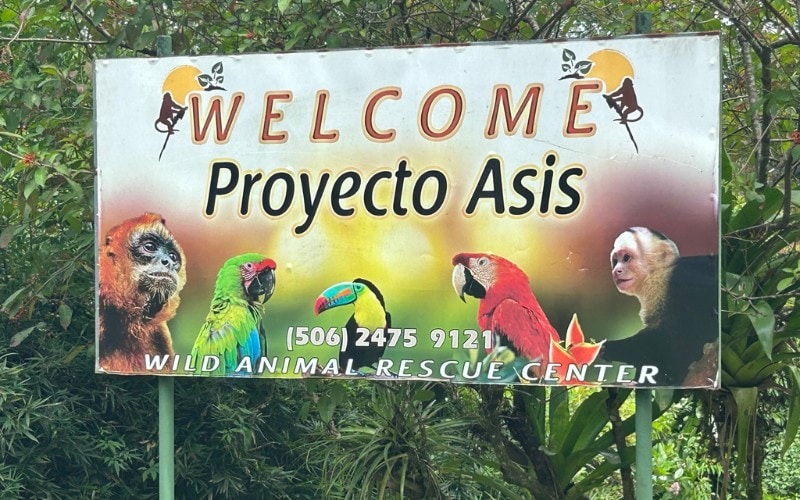Spending an Amazing Day at Proyecto Asis Wildlife Refuge in Costa Rica
Artsy Traveler contains affiliate links for products and services I personally use and can happily recommend. As an Amazon Associate, I earn from qualifying purchases. Please read the Disclosure for more information. If you make a purchase through these links, at no additional cost to you, Artsy Traveler earns a small commission. Thank you!
I highly, highly recommend spending a day at a wildlife refuge while traveling in Costa Rica.
Just make sure you do your research and find a reputable one that places the animals’ best interests far above those of tourists.
I did quite a bit of searching online before selecting Proyecto Asis for my wildlife refuge day. Its numerous five-star reviews and assurances that it existed for the benefit of the animals in its care convinced us.
A non-profit organization, Proyecto Asis provides a secure home to orphaned, abandoned, injured or otherwise neglected animals.
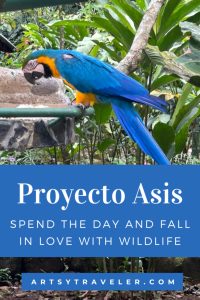
Overview of Proyecto Asis
The intention is to eventually release the animals back to the wild. Unfortunately, humans have damaged some of the animals so badly that they can never again live safely outside captivity.
We learned all this during the course of the day, and it was fascinating–and also very sad.
Proyecto Asis is located about 45 minutes from La Fortuna in a beautiful area of farms and forests. If you’re driving, you can get there easily from La Fortuna, or you can ask Proyecto Asis to hire a driver for you (that’s what we did).
Established in 2002, Proyecto Asis is now an animal rescue center, Spanish school, and volunteer center.
Booking a Day at Proyecto Asis
I booked our day at the Proyecto Asis a few months before our visit to Costa Rica. Their website provided several options. We chose to do the sloth walk in the morning, the tour of the wildlife refuge in the afternoon, and an hour or two of volunteering at the end of the day.
I’m very glad we chose to stay for the whole day. Having that much time at the wildlife refuge gave us a good feel for the place and for the excellent work it does protecting animals.
I could have happily spent another whole day there. Proyecto Asis has several programs to accommodate a range of interests, so if wildlife conservation is your thing, you’ll likely find some good options.
Getting to Proyecto Asis
Proyecto Asis has organized a transfer for us from the Tabacon Hot Springs Resort near La Fortuna. Promptly at 9:30 am, our driver Alfonso arrives to pick us up. He speaks good English and gets us to the refuge right on time.
On the way, he pulls into a fruit stand and emerges holding two containers of freshly chopped papaya, pineapple, and watermelon that he presents to us.
How thoughtful! The fruit is achingly fresh and refreshing and way better than the fruit at the hotel breakfast.
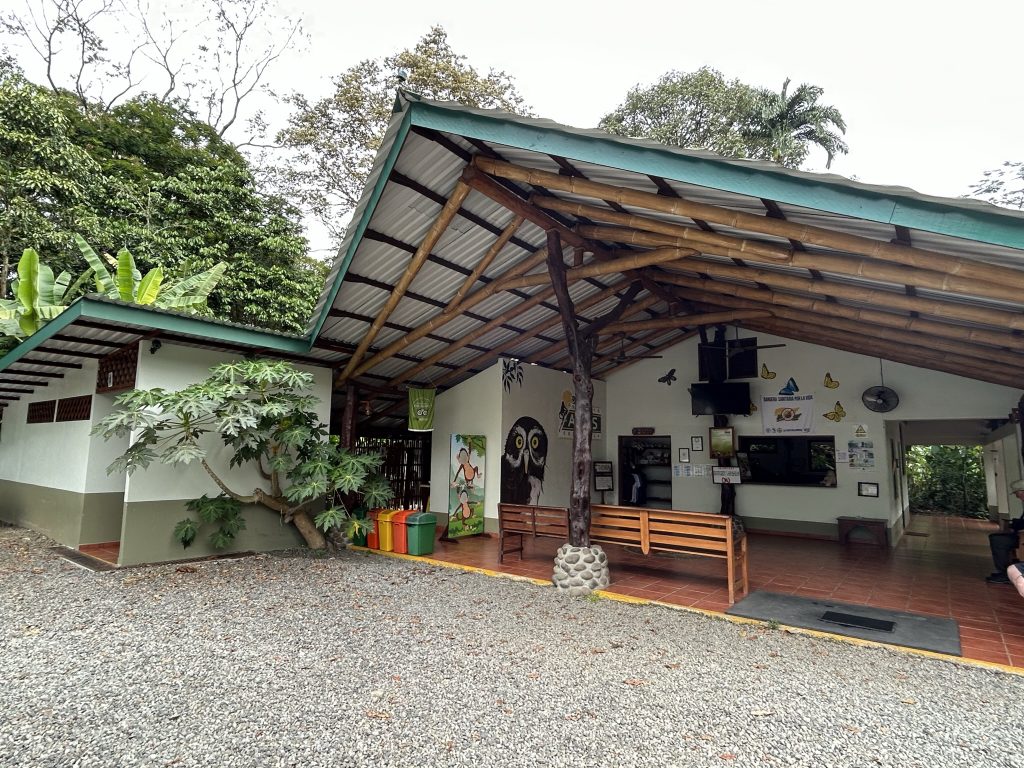
Touring the Sloth Sanctuary
After arriving at Proyecto Asis, we are warmly greeted and our fruit stored for the day in the refrigerator. After spraying ourselves with bug repellant (in the parking lot, not in the forest, to avoid affecting the animals!), we join a family of four for a tour of the sloth sanctuary across the road.
The sanctuary is home to many sloths who live in the wild. While there are informative plaques dotted around the pathways, the sanctuary is not a zoo.
Our guide Jonny shares his enthusiasm and extensive knowledge about sloths, stopping every so often during our walk to share information about the four different species of sloths. We don’t see any other wildlife, although Jonny tells us that the week before, he spotted a three-meter boa. I can’t say I’m sorry I didn’t see it too.
Seeing Sloths
Like Luis, our guide at the Arenal Night Walk (described in my post See Costa Rica in Two Packed and Perfect Weeks), Jonny carries a large telescope on a tripod. Without it, seeing any sloths at all beyond brown fur balls high in the trees will be impossible. Jonny also has a contraption to strap the iPhone to the telescope to take pictures and videos of the sloths.
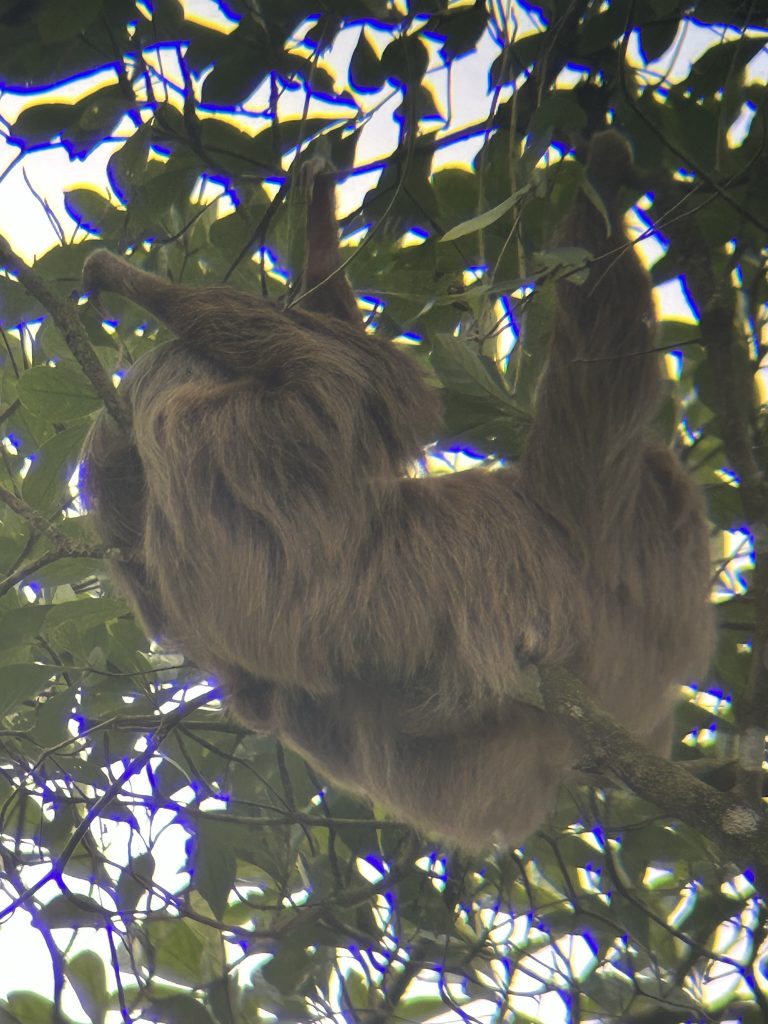
Learning About Sloths
One of my favorite exhibits at the sloth sanctuary is of the massive prehistoric sloth—twenty feet high and nothing like his furry, bug-infested ancestor. This guy was anything but cute!
We learn that hundreds and hundreds of insects buzz around the sloths hanging out in the trees. Through the telescope, we can see so many that the sloths appear blurry. When a sloth does move, it is to scratch itself, which is hardly surprising.
Jonny tells us that baby sloths stay with Mama for five months. Mama then brings baby down to the ground and leaves it there to fend for itself because presumably by that time it knows how to be a sloth.
Hearing from the Guide
Here’s a clip of Jonny talking about sloths. His enthusiasm for his subject is infectious.
In recent years, these creatures, which are actually not at all cuddly and even dangerous to get near as a result of the bugs infesting them, have become incredibly popular. Sloths are the unofficial mascot of Costa Rica. Their images are everywhere–from T-shirts to tea towels and every possible thing in between.
Enjoying this post? Subscribe to Artsy Traveler to Receive Valuable Travel Tips and Your FREE Guide: 25 Must-Do Artsy Traveler Experiences in Europe for 2025

Unfortunately, their popularity has led to some so-called wildlife parks exploiting them to entertain tourists. However, the Costa Rican government is doing its best to crack down on questionable wildlife practices and is shutting down facilities that do not protect the animals.
The sloth walk is through very lush jungle that includes plenty of vibrant flowers. The air hums with insects and the heat and humidity are tropical but still comfortable for walking.
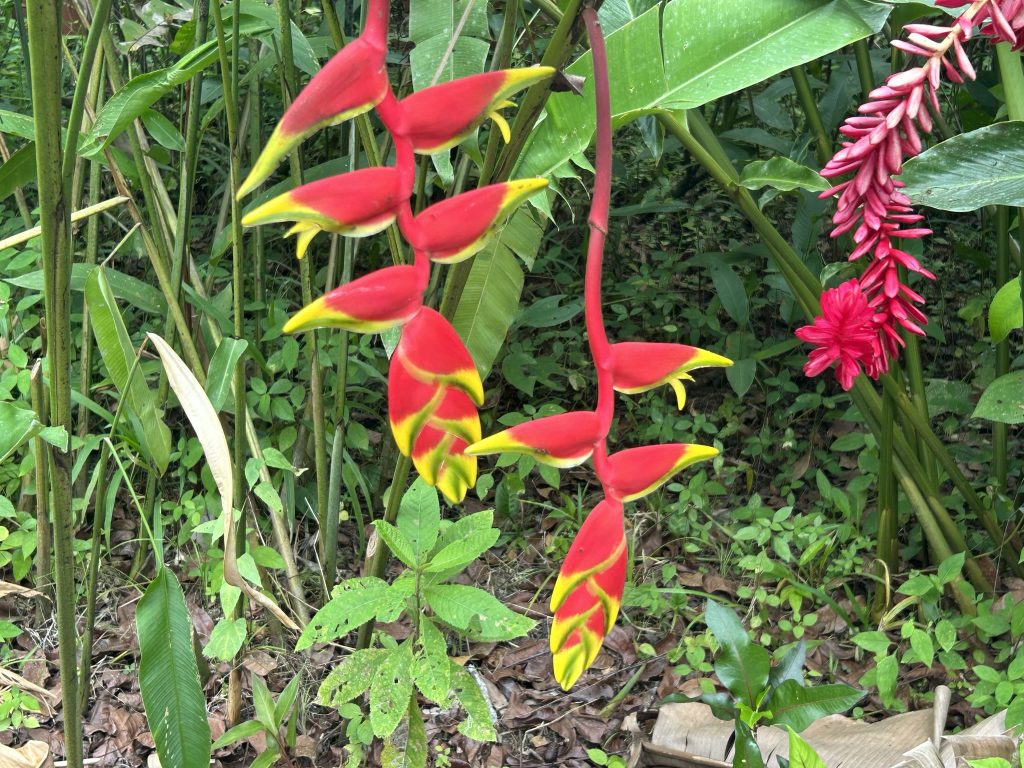
Lunch at a Soda
After the sloth walk, we walk down the road to a soda, which is a small restaurant run by locals, to enjoy food that is hearty, typical, and cheap. We both enjoy excellent meals plus pineapple drinks for about 11000 colóns, which is less than $20 USD. It is a bargain for sure.
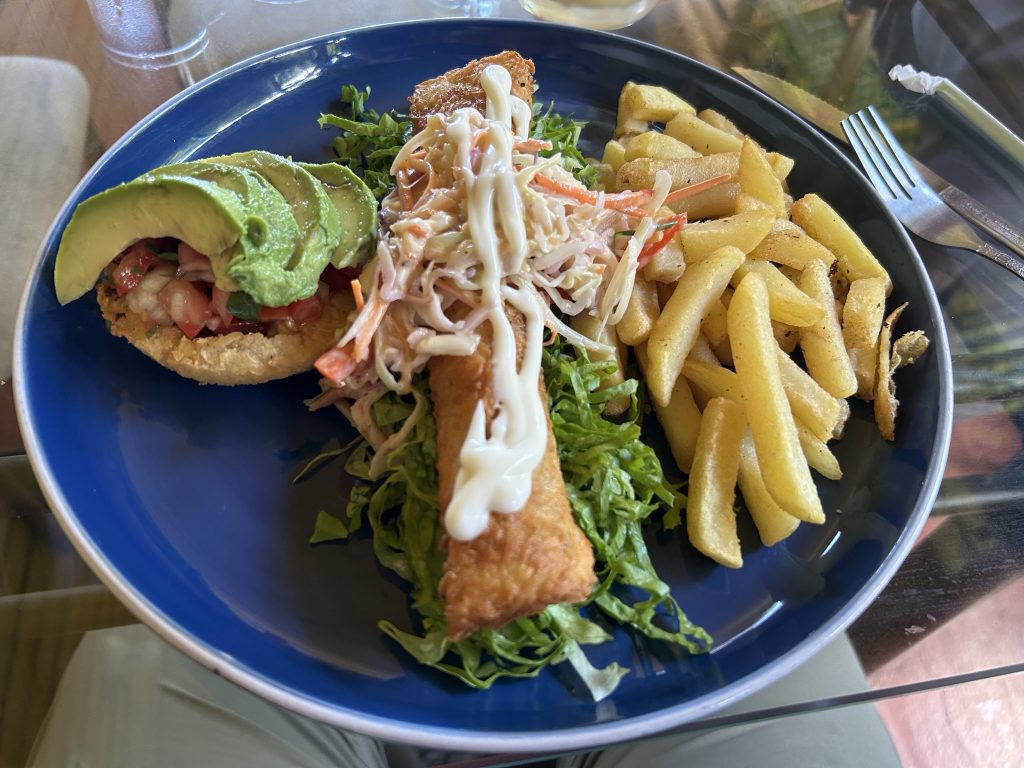
Wildlife Refuge Tour
After lunch, we walk back to Proyecto Asis for the wildlife refuge tour. I have no idea what to expect. To my surprise and delight, the next two hours fly by during probably the most interesting and comprehensive tour I’ve ever been on for anything, anywhere (and I’ve been on my fair share of tours over the years).
Much of the appeal of the tour is due to the personality and enthusiasm of Carlos, our guide. Numerous Trip Advisor reviews mention him by name and no wonder. The man is a gifted entertainer and so passionate about communicating and educating visitors about wildlife preservation and rehabilitation.
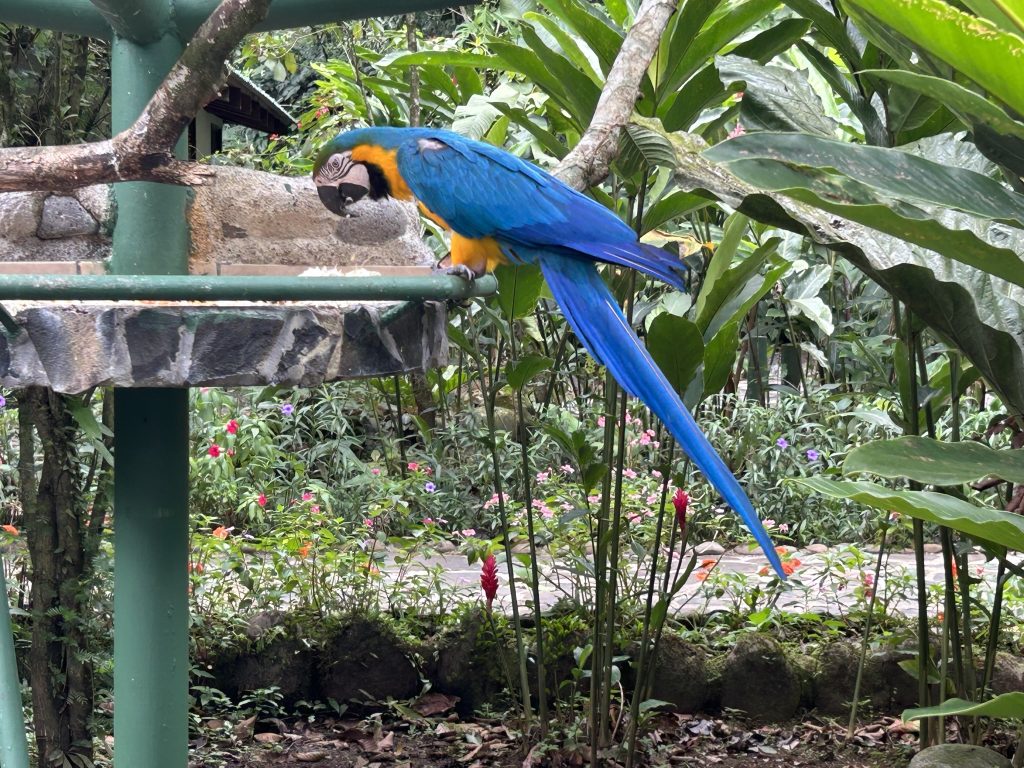
Learning About Rescue Animals
All the animals at the Proyecto Asis Wildlife Refuge are rescued, the vast majority from homes where, tragically, they were kept as pets. It’s so sad to hear their stories.
Carlos stops at every cage and introduces the animal, tells us its story, and describes how the staff at the refuge are rehabilitating the animal back into the wild. For some, the process will take years; for others, just a few months depending on the severity of injury and trauma the animal has suffered.
A few of the animals are so damaged that they will never be able to survive in the wild. At least they will live their lives securely and be well fed, with plenty of other animals to keep them company.
Carlos talks a lot about how animals in captivity often exhibit unnatural behaviors. Here he explains why parrot “talk”!
Monkeys at Proyecto Asis
The animals in the refuge vary so you never know what you’ll see. On the day we visit, we see spider monkeys and white-faced monkeys, two of the five species of monkeys in Costa Rica. Some are wild monkeys that have been hit by cars and need to recover from their injuries before being returned to the forest. These are the luckier ones. At least they know how to live in the wild.
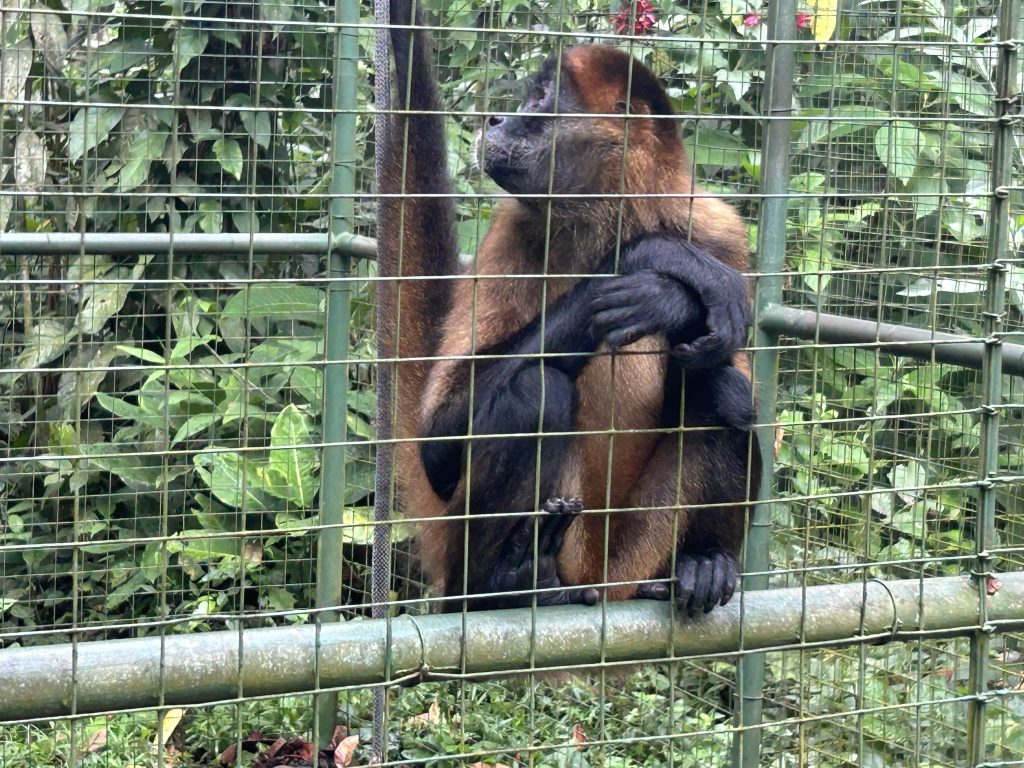
The saddest stories are of the poor creatures who were taken from the wild as babies and then kept chained up for years until finally their owners tired of them and dumped them at the refuge. These monkeys need to learn how to be monkeys again.
Carlos spends a lot of time describing the various ways in which they retrain the monkeys, always with the intention of preparing them for the wild. While they do name the monkeys to identify them, they do not interact with them as pets. They are wild animals—or soon to be—and the respect for them is palpable and so admirable.
Here Carlos explains about monkeys and their tails.
Carlos emphasizes over and over again how they do not want to make the animals playthings of humans, that they deserve to have their own lives as free and wild creatures. All behaviors that are not found in the wild are slowly changed, usually by the animals themselves.
A monkey that arrives at the refuge not knowing how to swing by its tail because it never got the chance to learn while in captivity eventually learns by watching the other monkeys.
How Monkeys Become Pets
Carlos tells us how people get monkeys to sell as pets. They go into the forest and take baby monkeys. And how do they get a baby monkey? They kill the mother because if they don’t, the mother will attack. So, two lives are ruined, and for what? It’s heartbreaking, but also heartening because facilities like the Proyecto Asis are doing incredible work.
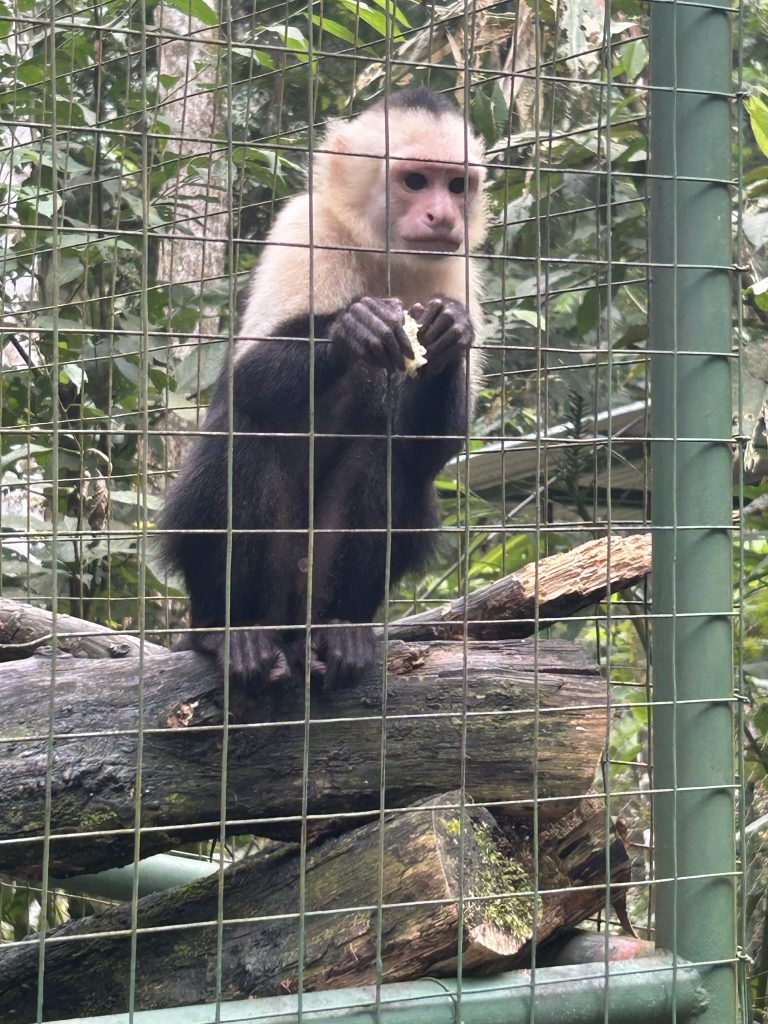
A Green Boa
While standing in front of one of monkey cages, we see this beautiful fellow slowly slithering past. He pays zero attention to us.
Tropical Birds at Proyecto Asis
In addition to the monkeys, the refuge takes care of a great variety of tropical birds, particularly toucans, macaws, and parrots. Almost all these birds were once pets. Most have come to the refuge without their tail feathers and some with broken wings, clipped wings, and worse. The birds are so damaged that rehabilitating them can take years. In fact, some of the birds will never be released.
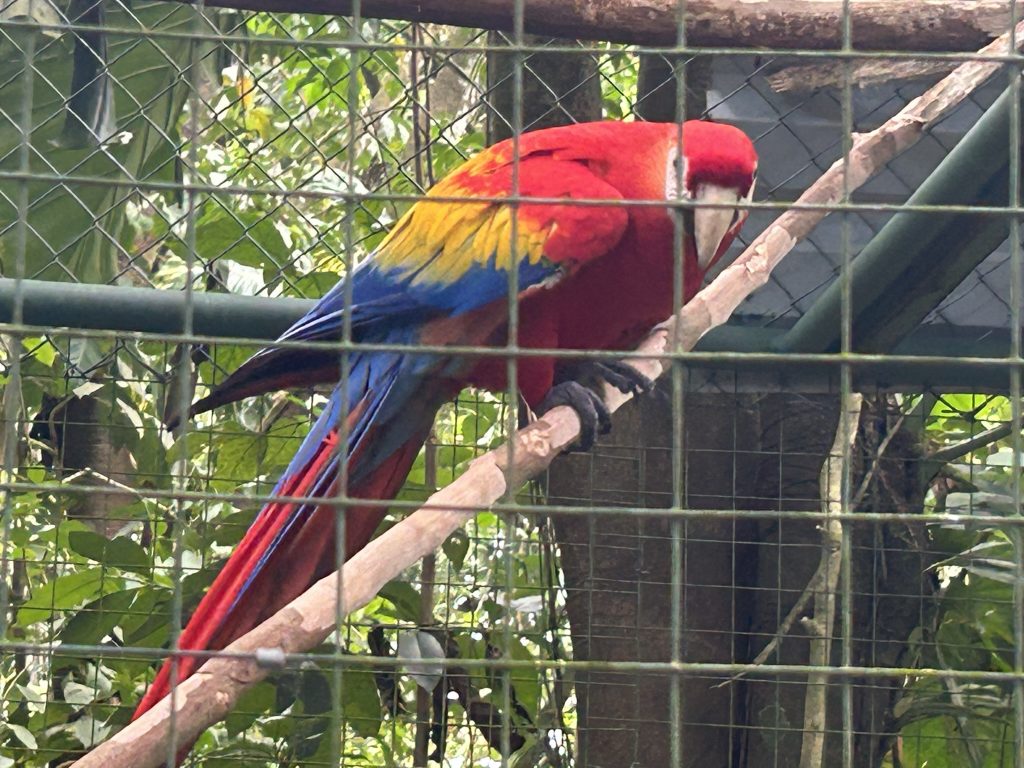
Macaws
Macaws are known to mate for life. When one dies, the other usually dies within weeks. But what self-respecting red or green macaw will mate with a hybrid? None.
We also learn that parrots are not monogamous. When a mate dies, the survivor quickly finds another mate. Interestingly, the parrots live about 40 years. The macaws with their one-mate-for-life live for about 100 years. One point for monogamy!
Carlos explains about how parrots that are separated can get depressed and then die.
A Hybrid Macaw
One of the most tragic stories is of a macaw that was bred from a red macaw and a green macaw. This combination is impossible in nature, because the two species of macaws live in different parts of Costa Rica and would never meet, never mind mate. But some horrible person did manage to mate a red one with a green one. The resulting offspring will forever live at the refuge because in the wild, it couldn’t survive in the area where the red macaws live and it couldn’t survive in the area where the green macaws live.
The hybrid is apparently worth a great deal of money because its plumage is so striking, although so, so wrong. Fortunately for the hybrid, it’s found a good home at Proyecto Asis well away from wildlife traffickers.
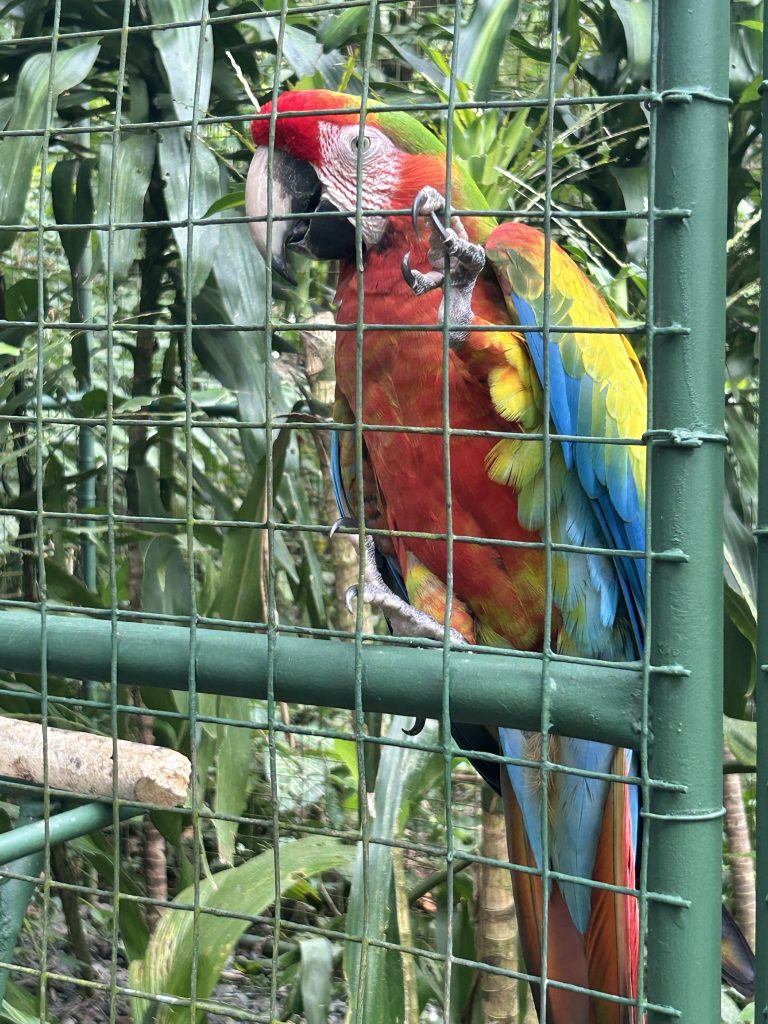
I love the toucans; and there are plenty at the refuge. They are so comical to watch, with their large beaks. It’s great to be able to get so close to them.
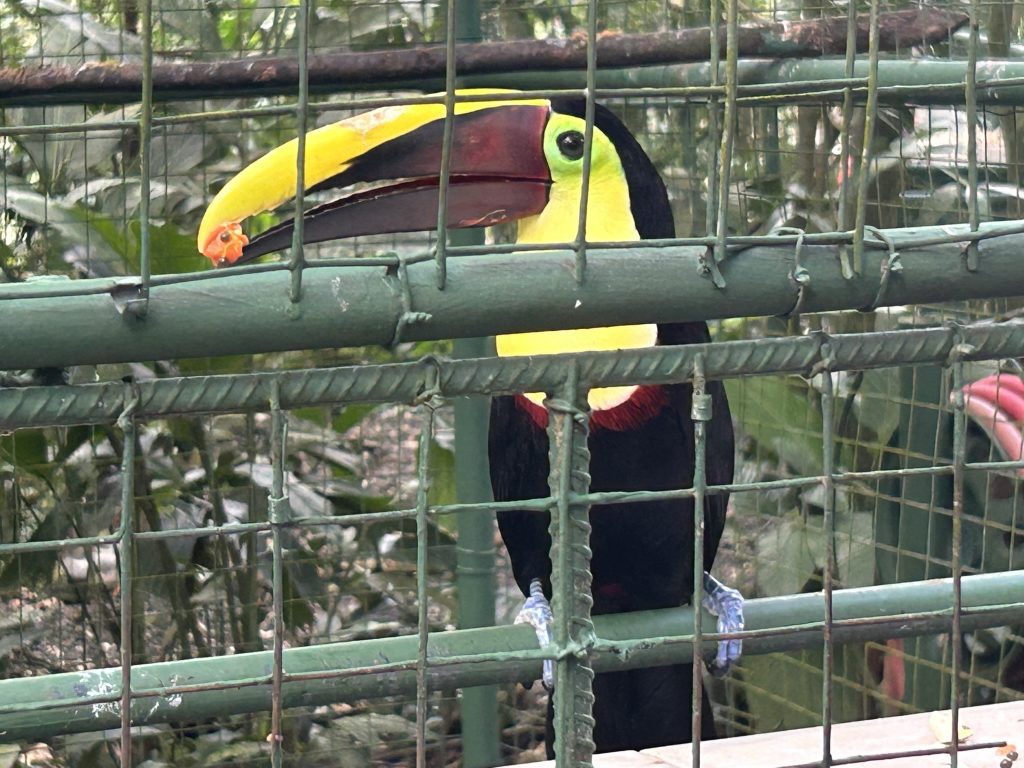
Carlos never stops talking for two hours and everything he says is fascinating. I am riveted and inspired.
Volunteering at Proyecto Asis
After the wildlife tour (we also see three wild pigs, two caimans, and a morgay, which is a type of small wildcat), Carlos teaches Julia, me, and one other person from the refuge tour how to chop fruit and veggies to feed the monkeys.
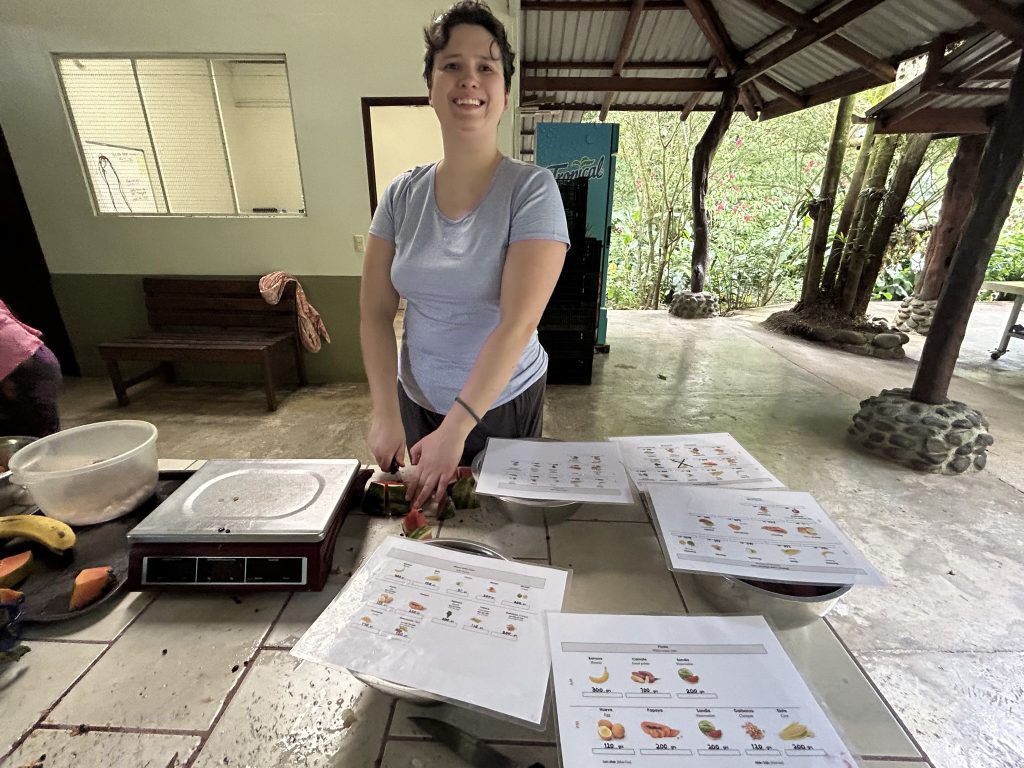
Again, Carlos keeps up a steady stream of commentary about how the animals are fed, how he makes sure the alpha males don’t steal every portion, etc. I learn so much!
After we chop the fruit, Carlos leads us to the monkey enclosures, and we get to watch while the monkeys eat their dinner. But only some of the monkeys! We learn that the refuge doesn’t allow guests to watch the same monkeys eat every day. Guests are rotated between the various monkey cages so that all monkeys get at least a few days a week to eat in privacy. Apparently, privacy has been identified as an important need for the monkeys, which makes sense. I wouldn’t want people watching me eat all the time either.
Conclusion
At the end of our wonderful day at Proyecto Asis, a different driver picks us up and whisks us back to La Fortuna. We ask him to drop us in the town rather than taking us to Tabacón Grand Spa Thermal Resort, which is about 7 kilometers away. For several hours, we enjoy wandering around the shops and then having a meal.
Sign up for a tour of a wildlife refuge when you visit Costa Rica. You won’t be disappointed! And check out my long post about my visit to Costa Rica: See Costa Rica in Two Packed and Perfect Weeks
Here are some other tours in Costa Rica:
